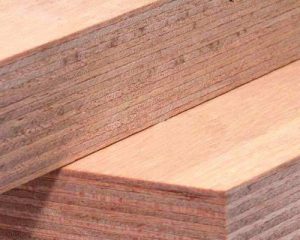Strength comparison
Plywood board has high strength. It preserves the long fiber structure and also eliminates deformation stress due to the vertical and horizontal placement of veneer, which not only improves the stability of growth, but also improves the strength of wood. Relatively speaking, particle board destroys the long fiber, and its strength is far less than that of pure solid wood board.
Plywood sheet uses homemade high-quality environmentally friendly glue in the production process. Both multilayer board and particle board are environmentally friendly products. If you have to compare, multilayer board is better!
Stability comparison
Because plywood has a unique criss-cross structure and are made through several processes such as cold pressing, hot pressing, and sanding, the defect of easy deformation of solid wood boards is solved from the perspective of internal stress. The stability is particularly good, and there is no need to worry too much about it being affected by moisture and deforming. In addition, compared with particle boards, plywood also have advantages such as strong selectivity and convenient maintenance.
Raw materials
Multi-layer plywood boards are made from the trunk of trees, which are then cut into sheets of solid wood veneers, and then each sheet is processed through multiple processes such as gluing and pressing. The boards are arranged horizontally and vertically, so the structure of the boards is more stable. At the same time, the moisture content and size of the boards need to be strictly screened. Particle board which is made by spraying glue on wood particles such as sawdust and scraps. The internal structure of the particle board is staggered, and once a nail enters, it can bite well, so its nail holding force is particularly good.
Environmental protection
As we said before, multi-layer boards are made of solid wood veneers, so the coating surface is less and the amount of glue used is also reduced. CUZI INDUSTRY use high-cost formaldehyde-free glue to produce, so that the environmental protection level of multi-layer boards can reach E1 level, or even European E0 level. Therefore, it is particularly environmentally friendly. However, particle boards use more glue than multi-layer solid wood because of their granular internal structure. In order to reduce costs, some manufacturers will use some cheap trialdehyde glue, resulting in a large amount of formaldehyde inside the particle board. Therefore, the environmental protection level of particle boards can only reach E0 level or even lower.
Price
Although both materials are environmentally friendly, their stability is not as high as other boards. Solid wood particles are light in weight. In terms of price, solid wood particle boards are cheaper and more affordable.
Which is better for wardrobes, solid wood particle board or solid wood multilayer board?
1.Low cost of particle board
The purchase price of particle board is relatively low, the difficulty of secondary processing is low, no painting is required, and it is easy to make.
2.Strong decorative properties of particle board
The decorative properties of particle board are relatively strong, and it performs well in terms of moisture resistance, scratch resistance, and high temperature resistance.
There are many colors and the surface can be flat or embossed. It is the most common coating method for most cabinets and wardrobes.
3.High efficiency of particle board
Particle board is suitable for large-scale mechanical processing, the precision is easy to control, the output is high, and the transportation is convenient.
What are particle board and multilayer board?
1.Particle board is made by crushing various branches into particles and then gluing them under high pressure. Because its cross-section is similar to a honeycomb, it is called particle board. Most of the panel furniture in the world now uses this kind of board. The advantage is that the internal structure is cross-staggered particles, so it has good nail holding force and lateral load-bearing capacity, and the cost is lower than medium-density fiberboard. Although the formaldehyde content is higher than medium-density fiberboard, it is much lower than that of large core board; the price is relatively cheap.
Disadvantages: Because the manufacturing method is easy, the quality varies greatly and is difficult to distinguish. The bending and tensile resistance are poor, and the density is loose and easy to loosen. The surface is often double-sided pressed with melamine veneer, and the appearance is the same as medium-density fiberboard after edge sealing.
2.Plywood is a three-layer or multi-layer plate material made by peeling wood segments into veneers or planing wood blocks into thin wood, and then gluing them together with adhesives. It usually uses an odd number of veneers, and glues the fibers of adjacent veneers perpendicular to each other. The plywood product has a flat appearance, a large width-to-thickness ratio, and a large surface area per unit volume. This appearance feature brings about its characteristics in use: (1) It has a large surface area, so it has a strong capacity for coverage and widely used in chemical industry, containers, construction, metal products, metal structures etc; (2) It can be arbitrarily cut, bent, stamped, welded, and made into various product components. It is flexible and convenient to use and occupies an extremely important position in the automotive, aviation, shipbuilding, and tractor manufacturing sectors; (3) It can be bent and welded into various complex-section steel sections, steel pipes, large I-beams, channel steels and other structural parts, so it is called “universal steel.”
Production characteristics
(1) The plywood board is rolled out with flat rollers, so it is relatively simple and easy to change the product specifications, and the adjustment operation is convenient. It is easy to realize comprehensive computer control and automatic production;
(2) The shape of the plywood is simple and can be produced in rolls. It is used in the largest amount in the national economy, so high-speed continuous rolling production is necessary and can be achieved;
(3) Due to the large width-to-thickness ratio and surface area, the rolling pressure in production is very high, which can reach millions to tens of millions of Newtons. Therefore, the rolling mill equipment is complex and large, and the control of the product width and thickness dimensional accuracy, plywood shape and surface quality has become very difficult and complicated.

